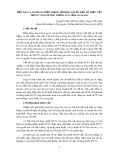
BioMed Central
Page 1 of 7
(page number not for citation purposes)
Cough
Open Access
Research
Cough reflex and oral chemesthesis induced by capsaicin and
capsiate in healthy never-smokers
Miyako Yamasaki, Satoru Ebihara*, Takae Ebihara, Shannon Freeman,
Shinsuke Yamanda, Masanori Asada, Motoki Yoshida and Hiroyuki Arai
Address: the Department of Geriatrics and Gerontology, Tohoku University School of Medicine, Seiryo-cho 1-1, Aoba-ku, Sendai, 980-8574, Japan
Email: Miyako Yamasaki - ymsk@geriat.med.tohoku.ac.jp; Satoru Ebihara* - s_ebihara@geriat.med.tohoku.ac.jp;
Takae Ebihara - takae_montreal@hotmail.com; Shannon Freeman - shannon2@yahoo.ca; Shinsuke Yamanda - fullback15@mtj.biglobe.ne.jp;
Masanori Asada - asada@geriat.med.tohoku.ac.jp; Motoki Yoshida - m-yoshida@geriat.med.tohoku.ac.jp;
Hiroyuki Arai - satoru_montreal@hotmail.com
* Corresponding author
Abstract
Background: Many tussive agents are components of foods, but little is known about the
relationship between cough reflex and oral chemesthesis sensitivities. We investigated the
relationships between cough reflex and oral chemesthesis in individuals using two transient
receptor potential vanilloid 1 (TRPV1) agonists with different potencies: capsaicin and capsiate.
Methods: Twenty-eight healthy never-smokers were allocated to evaluate cough and oral
chemesthesis of capsinoids. Cough reflex sensitivities are estimated by the lowest concentrations
generating five coughs by each TRPV1 agonist inhalation. Oral chemesthesis sensitivities are
estimated by the lowest concentrations which generate a hot sensation when filter paper loaded
with each TRPV1 agonist is placed on the tongue.
Results: There were strong correlations between capsaicin- and capsiate-induced cough reflex
sensitivities, and between capsaicin- and capsiate-induced oral chemesthesis sensitivities. However,
there were no significant correlations between cough reflex and oral chemesthesis sensitivities
induced by both capsaicin and capsiate. The cough reflex sensitivities are significantly greater in
females than in males whereas there were no gender differences in oral chemesthesis.
Conclusion: The results showed that the sensitivities of sensory afferents were different between
cough reflex and oral chemesthesis, suggesting that TRPV1 sensitivities differ between organs
within healthy individuals. Capsiate could be a tussigen for the cough challenge test.
Background
Although many tussive agents, such as capsaicin, citric
acid, and acetic acid, are components of foods, it is
unknown whether these chemical stimuli equally stimu-
late sensory nerves in bronchial airways and the oral cav-
ity. The inhalation of tussive agents as a cough challenge
test is a useful method to quantify cough in a clinical set-
ting and to assess the antitussive effects of specific thera-
pies in a laboratory setting [1]. The inhalation cough
challenge is applied via the oral cavity, but little attention
has been paid to the effects of tussive agents on oral sen-
sory systems during the cough challenge test. Although,
Published: 31 October 2007
Cough 2007, 3:9 doi:10.1186/1745-9974-3-9
Received: 7 June 2007
Accepted: 31 October 2007
This article is available from: http://www.coughjournal.com/content/3/1/9
© 2007 Yamasaki et al; licensee BioMed Central Ltd.
This is an Open Access article distributed under the terms of the Creative Commons Attribution License (http://creativecommons.org/licenses/by/2.0),
which permits unrestricted use, distribution, and reproduction in any medium, provided the original work is properly cited.

Cough 2007, 3:9 http://www.coughjournal.com/content/3/1/9
Page 2 of 7
(page number not for citation purposes)
while testing and developing the inhalation cough chal-
lenges, a large number of tussive agents have been tried,
capsaicin has stood the test of time and nowadays is the
most widely used probably as a result of greater reproduc-
ibility and safety [1]. In contrast to classical tastes such as
sweet, salty, bitter, sour and umami, the oral sensation
induced by capsaicin is called chemesthesis, a sensation of
irritation produced by chemical stimulation and medi-
ated by the trigeminal nerve [2].
The physiological effects of capsaicin on cough may be
modulated by oral sensory stimuli. Activation of capsai-
cin-sensitive afferents in the tongue and palate evoke local
release of neuropeptides such as substance P and calci-
tonin gene-related peptides, which are contained in the
nerve terminal of the sensory neurons [3,4]. The neu-
ropeptides exert powerful vasoactive and secretomoter
effects leading to vasodilation, plasma exudation, trigger-
ing reflex salivation and an increase in the secretion of
mucus in the airway. Capsaicin is a potent gustatory stim-
ulus which may also promote airway secretions. Gustatory
rhinorrhoea has been shown to occur after eating spicy
foods and this observation demonstrates a link between
gustation and airway secretion of mucus [5]. There is also
a possibility that capsaicin in the oral cavity induces bron-
choconstriction the same as intranasal application of cap-
saicin elicits bronchoconstriction [6].
Moreover, in the brain, the gustatory fibers and the sen-
sory fibers that initiate cough may interact with each other
because of the close anatomical relationship [7]. In order
to inquire into the possible modulation of cough reflex by
capsinoid-induced oral stimuli, it might be important to
know whether there is a relationship between cough reflex
and oral sensitivities to capsinoids. In addition, for the
same purpose, it may also be important to know whether
there is a gender difference in oral sensitivities to capsi-
noids since cough reflex sensitivity to capsaicin shows
prominent gender differences [8,9].
Capsaicin acts mainly on the afferent neurons of the non-
myelinated C-fibers by the opening of a non-selective cat-
ion channel of capsaicin receptor, transient receptor
potential vanilloid 1 (TRPV1) [10]. Capsiate is obtained
from faint-pungent cultivar of red peppers named CH-19
Sweet [11]. CH-19 Sweet is a fixed cultivar that was
selected and cultivated from a pungent cultivar, CH-19, of
pepper. Capsiate is known to activate TRPV1 [12], and,
despite faint-pungency, increases adrenaline secretion
and oxygen consumption like capsaicin [13]. Capsium
fruits are used worldwide in foods for their pungency. The
pungency felt when eating Capsium fruits is mainly attrib-
uted to the activation of oral TRPV1 [14].
TRPV1 receptors found on sensory airway nerves are
important in the cough reflex [15]. Isolated pulmonary
vagal afferent nerves are responsive to TRPV1 stimulation.
When one eats foods containing capsaicin, the burning
sensation is elicited by TRPV1-containing peptidergic
nociceptors surrounding taste buds in the tongue [16].
Capsaicin-induced cough may not solely be mediated
through the nerves expressing TRPV1 receptors. Capsaicin
inhalation elicits cough through the activation of rapidly
adapting receptors (PAR) [17,18]. The activation of PAR is
presumably secondary to airway smooth muscle contrac-
tion, mucous secretion or edema formation by capsaicin
[18]. Therefore, cough induced by capsaicin is a mixture
of direct and indirect responses to the capsaicin. The same
situations are also proposed for oral chemesthesis.
Despite the complexities of the neural network and
involved mechanisms to induce cough or oral chemesthe-
sis, the outcome measurements are relatively simple in
these phenomena.
In order to investigate the possible relationship between
the perception of sensations mediated by TRPV1, whether
directly or indirectly, in different organs, e.g. lung and
tongue within individuals, we compared cough reflex and
oral chemesthesis sensitivities using two TRPV1 agonists
with differential potencies, capsaicin and capsiate. In
addition, we evaluated the possibility of the use of capsi-
ate as a cough challenge test.
Methods
Subjects and protocols
Twenty-eight healthy never-smokers (14 male, 14 female)
were allocated to evaluate cough and oral chemesthesis of
capsinoids. All were originally recruited via public post-
ings in and around the Tohoku University School of Med-
icine campus. The mean age was 36.4 ± 2.3 (SE) years. The
study was approved by the Institutional Review Boards of
Tohoku University School of Medicine. Subjects were
without history of pulmonary disease, recent (within 4
weeks) suggestive symptoms, respiratory tract infection
and seasonal allergies. Subjects did not take any regular
medication.
Subjects underwent the sensitivity tests on four successive
days at 10:00 am. Each of the four days was assigned to
the capsaicin cough sensitivity test, the capsaicin oral
chemethesis test, the capsiate cough sensitivity test, or the
capsiate oral chemesthesis test. The order of the four tests
was randomly decided using a computer program. The
day before the start of the test and during the four days,
subjects were prohibited from taking any capsinoids in
meals or beverages. In order to ensure subjects avoid con-
sumption of capsinoids during meals, various foods and
dishes that contain them were explained to the subjects.

Cough 2007, 3:9 http://www.coughjournal.com/content/3/1/9
Page 3 of 7
(page number not for citation purposes)
Cough reflex sensivity tests for capsaicin and capsiate
Cough reflex sensitivities to capsaicin and capsiate were
measured on different days using the modification of the
method by Fujimura and colleagues [8]. 30.5 mg of Cap-
saicin (Sigma Aldrich, Seatle, USA) was dissolved in
Tween 80 (1 ml) and ethanol (1 ml) and then dissolved
in physiological saline (8 ml) to make a stock solution of
0.01 M, which was stored at -20°C. This solution was
diluted with physiological saline to make testing solu-
tions starting at a concentration of 0.49 µM and increasing
it by doubling the concentration up to 1000 µM.
Capsiate was extracted from CH-19 sweet (kind gift from
Ajinomoto KK, Kawasaki, Japan). Compared with capsai-
cin, capsiate has an ester bond instead of the amide bond
between the vanillyl moiety and fatty acid chain (Figure
1). Harvested chili peppers (CH-19 sweet) were washed
and dried. Then the crude oil was extracted from the dried
chili peppers using n-hexane. The crude oil was refined by
the distillation and the column chromatography. Finally,
in order to adjust the concentration, the refined oil was
diluted with medium-chain triglyceride. In this original
capsiate extract solution, the capsiate content of the sam-
ple was ~7%. The rest of the extract solution was mainly
caprylic acid. Capsaicin was less than 0.0001% among
capsinoids. 70 µl of capsiate extract was dissolved in
Tween 80 (1 ml) and ethanol (1 ml), and then dissolved
in physiological saline (19 ml) to make a solution of 0.01
M. This solution was diluted with physiological saline to
make testing solutions starting at a concentration of 0.49
µM and increasing it by doubling the concentration up to
1000 µM. Capsiate was diluted from the original extract
solution every time just before the sensitivity test.
Each subject inhaled a control solution of physiological
saline followed by a progressively increasing concentra-
tion of capsaicin or capsiate solution. Solutions were
inhaled for 15 s every 60 s, by tidal mouth-breathing,
while wearing a nose-clip from a Bennett twin nebulizer
(3012-60cc; Puritam-Bennett Co., Carsbad, CA, USA).
Increasing concentrations were inhaled until five or more
coughs were elicited. The nebulizer output was 0.21 ml/
min. The cough reflex sensitivities to capsaicin and capsi-
ate were defined as the lowest concentration of capsaicin
or capsiate that elicited five or more coughs (C5). In our
preliminary experiments, it was confirmed that the Tween
80 and/or caprylic acid dilutions at any concentration
used in saline without capsinoids did not induce cough
for 15 s inhalation.
Oral chemesthesis measurements
Chemesthesis to capsaicin and capsiate was measured
with a modification of the semi-quantitative clinical gus-
tometry using a filter-paper disc, which is routinely used
for the evaluation of dysgeusia in a clinical setting [19].
Again, chemesthesis to capsaicin and capsiate were meas-
ured on different days. The testing solutions were pre-
pared for both capsaicin and capsiate in the same way as
the cough reflex sensitivity measurements, but distilled
water was used instead of physiological saline. A droplet
of each testing solution was added to the filter paper disc
(8 mm diameter), and then the disc was placed on the left
side of the tongue 2 cm from the tip (i.e. locus for left
cholda tympani nerve), for one second. The filter discs
with the progressively increasing concentrations of capsa-
icin or capsiate were applied every 5 min, and the subject
was asked to gargle with distilled water during the inter-
val. Because irritant sensations take longer than classical
tastes, subjects were instructed to wait 10 s before making
a conclusion on their chemesthesis [16]. The chemesthe-
sis to capsaicin and capsiate were defined as the lowest
concentration of capsaicin or capsiate that elicited a pun-
gent or burning sensation for the subject. Although capsi-
noids have the possibility to elicit bitterness, the subject
was asked to ignore the bitterness [20].
In our preliminary experiments, it was confirmed that the
Tween 80 and/or caprylic acid dilutions at any compara-
ble concentrations in distilled water without capsinoids
did not induce oral chenesthesis, and it was certified that
there was no tachyphylaxis of responses to capsinoids
with 24-hour intervals for both cough reflex sensitivities
oral chemesthesis.
Statistical analysis
Results are expressexd as mean ± SE. Comparisons
between each threshold concentration in differential stim-
uli were performed by a paired t-test. Comparisons
between the sensitivities in males and females were per-
formed by the Mann-Whitney test. The correlations
between each threshold concentration in differential stim-
Structures of capsaicin and capsiateFigure 1
Structures of capsaicin and capsiate.
O
H
2
C
HO
N
H
CH
3
CH
3
O
O
CH
3
CH
3
OH
2
C
HO
O
Capsaicin
Capsiate

Cough 2007, 3:9 http://www.coughjournal.com/content/3/1/9
Page 4 of 7
(page number not for citation purposes)
uli were estimated by Pearson's correlation coefficient. A
value of p < 0.05 was considered statistically significant.
Results
Both cough reflex sensitivities and oral chemesthesis tests
were performed without any unpleasant feelings or side
effects after the tests for all subjects. The mean threshold
concentration to induce cough (log C5 value) was signifi-
cantly greater in capsiate (2.55 ± 0.09 log µM) than in cap-
saicin (1.20 ± 0.09 log µM) (p < 0.0001). The mean
threshold concentration to induce oral chemesthesis by
capsiate (2.22 ± 0.10 log µM) was significantly greater
than that by capsaicin (1.55 ± 0.11 log µM) (p < 0.0001).
The mean threshold concentration for capsaicin applica-
tion was significantly greater in cough reflex sensitivity
than that in oral chemesthesis (p < 0.03).
The mean threshold concentration for capsiate applica-
tion was significantly greater in cough reflex sensitivity
than in oral chemesthesis (p < 0.01).
As shown in Figure 2A, there was a strong correlation
between capsaicin- and capsiate-induced cough reflex sen-
sitivities (r = 0.79, p < 0.001). Similarly, as shown in Fig-
ure 2B, there was a strong correlation between capsaicin-
and capsiate-induced oral chemesthesis sensitivities (r =
0.64, p < 0.01). These results suggest that cough reflex and
pungent sensation are induced by stimulation of TRPV1
in each responsible organ.
However, there was no significant correlation between
cough reflex and pungent taste sensitivities induced by
capsaicin (r = -0.12, p = 0.50). Similarly, there was no sig-
nificant correlation between cough reflex and pungent
taste sensitivities induced by capsiate (r = 0.30, p = 0.22).
These results suggest that the same TRPV1 stimulation
induce differential strength of sensation according to the
organs within individuals.
Table 1 shows cough reflex sensitivities and oral chemes-
thesis classified by gender. The threshold concentrations
to induce cough reflex are significantly greater in males
than those in females for both capsaicin and capsiate (p <
0.03 and p < 0.05, respectively). However, in oral chemes-
thesis, there were no significant differences between males
and females for both capsaicin and capsiate.
Discussion
In this study, no significant relationship between cough
reflex sensitivity and oral chemesthesis to capsinoids
within individuals was found. The cough reflex to TRPV1
stimulations are less sensitive in males than in females
whereas there was no significant gender difference in the
oral chemesthesis to capsinoids. Here we showed that the
usefulness of capsinoids with respect to both their action
as a tussigen and the capability to evoke oral chemesthe-
sis.
A strong correlation between the threshold concentrations
between capsaicin- and capsiate-induced cough was
found. Similarly, the threshold concentrations between
capsaicin- and capsiate-induced oral chemesthesis signifi-
cantly correlated. In both sensations, capsiate required a
much higher concentration than capsaicin. The intragas-
tric administration of capsiate increases adrenalin secre-
tion and oxygen consumption in mice [21,22]. In
addition, capsiate suppresses T cell activation by inhibit-
ing NF-κB-dependent transcriptional activity [23]. These
studies suggest that capsiate shares biological activities
with capsaicin in spite of very weak pungency. However,
the reasons for the weak pungency of capsiate are not
clear. Iida and colleagues speculated that less accessibility
of capsiate to nociceptors due to its lipophilicity might
contribute to the weak pungency [12]. In our studies, the
Correlations between capsaicin- and capsiate-induced cough reflex sensitivities (A), and between capsaicin- and capsiate-induced oral chemesthesis sensitivities (B)Figure 2
Correlations between capsaicin- and capsiate-induced cough
reflex sensitivities (A), and between capsaicin- and capsiate-
induced oral chemesthesis sensitivities (B). The solid lines
represent regression lines.

Cough 2007, 3:9 http://www.coughjournal.com/content/3/1/9
Page 5 of 7
(page number not for citation purposes)
difference in threshold concentration between capsiate
and capsaicin are greater in cough reflex sensitivity than
oral chemesthesis. This may reflect lower accessibility to
TRPV1 responsible for cough reflex than that for oral
chemesthesis.
Individual variations in cough reflex sensitivities were
shown in the cough challenge test even in healthy sub-
jects. The variation exists regardless of methods of cough
challenge and tussive stimulants. Cough reflex is report-
edly less sensitive in men than women [8,9]. Although
oral chemesthesis also exhibits variability, a gender differ-
ence has not been investigated as far as we know. In our
study, the gender difference in cough reflex sensitivities is
consistent with previous observations, suggesting meth-
odological appropriateness even with capsiate. We
observed no gender difference in oral chemesthesis in
healthy subjects using two TRPV1 agonists with different
potencies. There are several reports showing an associa-
tion between oral chemesthesis and taste perception
[24,25]. However, the results of the gender difference in
taste perceptions are conflicting according to the stimuli
and methods [26]. Nasal chemesthesis is relatively better
investigated than oral chemesthesis because nasal irrita-
tion is an important issue in environmental public health,
and data about gender differences are conflicting [27]. In
contrast to chemesthesis, gender dependency in pain per-
ception is well documented [28]. Numerous studies dem-
onstrated that certain pain disorders occur with higher
prevalence, intensity, or duration in women than in men
[29].
The explanation for an increase in cough reflex sensitivity
in healthy females is unknown. One hypothesis is an
endocrine influence on the cough reflex. Recently, prolac-
tin was reported to enhance TRPV1 response in the pres-
ence of estrogen in rat sensory neurons [30]. However,
previous studies showing that postmenopausal women
have greater cough reflex sensitivity than premenopausal
women [8], and more frequently suffer from angiotensin-
converting enzyme inhibitor-induced cough [31] would
argue against this hypothesis. In addition, our result
showing no gender difference in oral chemesthesis may
also conflict with the systemic influence of sex hormones
on gender differences.
Both the peripheral and central explanations for why oral
chemesthesis are not correlated to cough reflex sensitivity
are postulated. The lack of relationship between oral
chemesthesis and cough reflex sensitivity within individu-
als may suggest a differential expression of TRPV1 accord-
ing to the organs within individuals. In patients with
chronic cough, increased expression of TRPV1 in airway
nerves was reported [15]. Inflammatory bowel disease is
associated with the upregulation of TRPV1 in the nerve
fibers of the colon [32]. Taste performance on the human
tongue varies with the density of fungiform taste buds,
which are heavily innervated by chemesthesis receptor
neurons [33]. Thus, the organ specific up-regulation of
TRPV1 is found in diseases. Differential oral chemesthesis
could result from the differential number of TRPV1 in the
tongue.
More importantly, the differential sensitivities to capsi-
noids between cough reflex and oral chemesthesis could
be reflected in the differential contribution of indirect
activation of afferent neurons. In cough response, capsai-
cin is known to activate not only C-fibers that have TRPV1
but also rapidly adapting airway mechanoreceptors (PAR)
that do not have TRPV1 [17,18]. PAR is activated by a
large number of mechanical and chemical irritant stimuli,
by inflammatory and immunological mediators, and by
airway and lung pathological changes [34]. Presumably,
capsaicin activates PAR indirectly by contraction of airway
smooth muscle or by an increase in extracellular liquid, or
by both mechanisms [34]. Thus, the secondary effect of
capsaicin is not small on cough reflex sensitivities. On the
other hand, indirect effects of capsaicin on oral cheme-
sethesis sensations have not yet been identified, suggest-
ing that the indirect effect might be negligible in oral
chemesthesis.
Besides the peripheral factors, central factors may be
involved in the differential sensitivities of TRPV1 stimula-
tion between cough reflex and oral chemesthesis within
individuals. In contrast to oral chemesthesis, which was
finally integrated by cortical processing, cough reflex is
essentially a brainstem reflex. Therefore, there is a possi-
bility that the gain of a cortical neural process is involved
in the differences in oral chemesthesis, but not in cough
reflex. Evidence of gustatory brainstem taste nuclei and
cortical connections, which potentially modulate these
processes, provide a plausible neural basis for a central
gain mechanism [35,36]. Recently, the possible modifica-
Table 1: Gender differences in cough reflex sensitivities and oral
chemesthesis
Male Female p value
Number 14 14
Age (year) 34.2 ± 2.0 38.5 ± 4.1 n.s.
Cough reflex sensitivity
Capsaicin (Log µM) 1.41 ± 0.12 1.00 ± 0.11 <0.03
Capsiate (Log µM) 2.72 ± 0.10 2.37 ± 0.13 <0.05
Oral chemesthesis
Capsaicin (Log µM) 1.51 ± 0.17 1.58 ± 0.13 n.s.
Capsiate (Log µM) 2.22 ± 0.15 2.22 ± 0.14 n.s.
Data are mean ± S.E. P-values are comparisons between males and
females in each variable by the Mann-Whitney test. n.s. denotes not
significant.

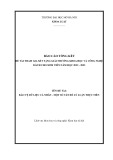


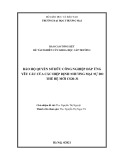
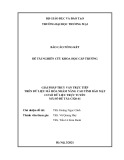

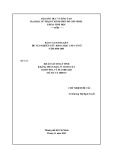
![Vaccine và ứng dụng: Bài tiểu luận [chuẩn SEO]](https://cdn.tailieu.vn/images/document/thumbnail/2016/20160519/3008140018/135x160/652005293.jpg)

